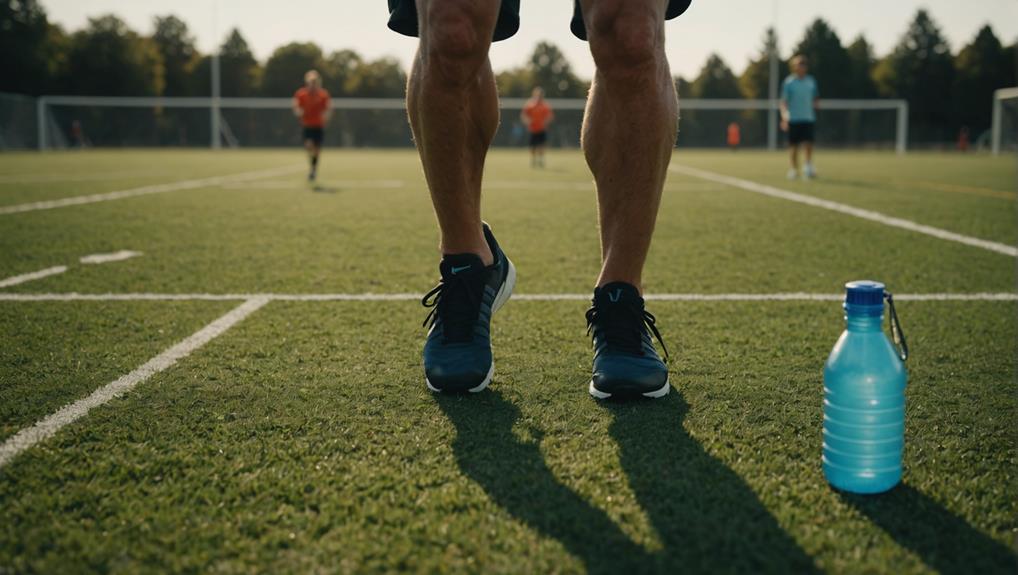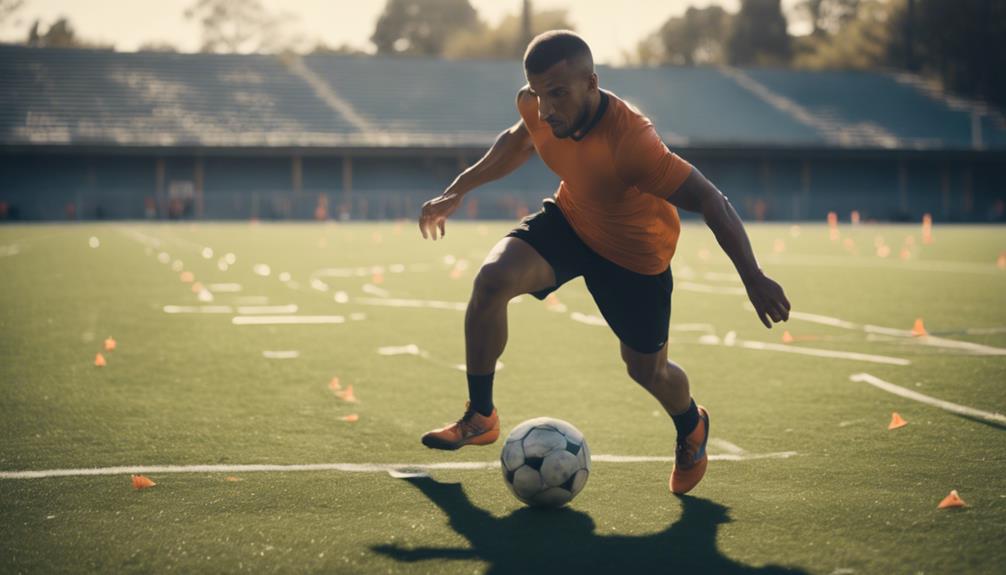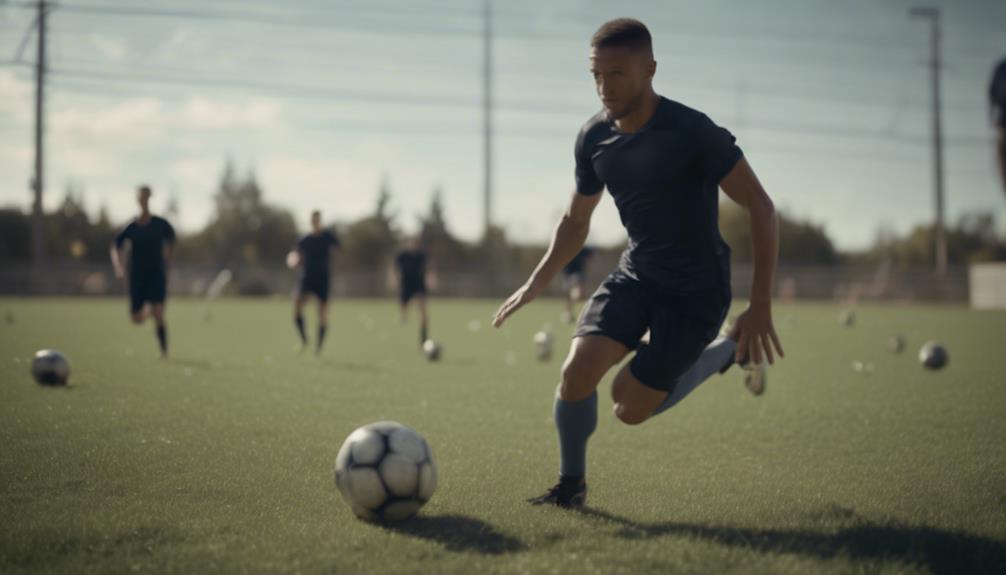
Top Cardio Workouts for Soccer Players
August 21, 2024Get the most out of your soccer game by focusing on top cardio workouts designed just for you. Sprinting routines will amp up your speed, agility, and anaerobic fitness, mimicking the intensity of match play. Try the 30/60s exercise for better cardiovascular endurance that aligns with the demands of soccer. Long-distance runs build your endurance, reducing fatigue during games. For a full-body recovery session, consider swimming to reduce soreness and improve circulation. These workouts will give you a winning edge on the field and help you take your game to the next level.
Cardio Training Overview
For soccer players, cardio training is an essential component in improving endurance and performance on the field. Soccer games demand high levels of stamina, with players running an average of more than five miles per match. To excel in the game, athletes need to incorporate a variety of cardio exercises like sprinting, jogging, and walking into their training routines. These activities help players build the necessary endurance to keep up with the fast-paced nature of soccer.
Cardio training not only enhances overall stamina but also aids in improving performance during sprints and jogs within the game. Players who engage in regular cardio workouts are better equipped to handle the physical demands of matches, making them more effective on the field.
Sprinting Routine Benefits
You'll love the benefits of incorporating sprinting into your workout routine!
Sprinting helps enhance your speed, boost your acceleration, and improve your agility on the field.
With quick rest intervals, sprinting drills are key to elevating your performance as a soccer player.
Sprinting for Speed
Enhancing speed and agility, sprinting serves as a fundamental component of soccer training, contributing greatly to your overall performance on the field. Regular sprint training not only improves your speed and acceleration but also enhances your anaerobic fitness, pivotal for quick bursts of energy during matches.
By incorporating sprint intervals such as the 30/60s exercise, you can replicate the intense nature of a soccer game, preparing yourself for the demands of the sport.
A recommended sprinting routine for soccer players typically includes 15-20 sprints of 20-30 meters each. These short, explosive efforts mimic the running patterns seen in a soccer match, helping you develop the necessary muscle memory for quick and agile movements on the field.
Additionally, consistent sprint training assists you in increasing your overall running distance, ensuring that you can cover more ground during games and maintain a high level of performance throughout.
Acceleration Training Tips
Improving your sprinting speed and explosiveness as a soccer player can be achieved through dedicated acceleration training routines.
To enhance your performance on the field, consider incorporating a sprinting routine that consists of 15-20 sprints covering short distances of 20-30 meters each.
Sprinting is a crucial skill in soccer, requiring players to quickly maneuver short distances with explosive speed.
Acceleration training plays a crucial role in helping soccer players develop the ability to swiftly change pace during a game, giving you an edge over opponents.
Quick Rest Intervals
Incorporating quick rest intervals into your sprinting routine is crucial for improving your cardiovascular endurance and speed as a soccer player. Interval training with short rest periods between sprints allows you to replicate the high-intensity bursts of running experienced during a game. These quick rest intervals not only enhance your cardiovascular endurance but also help boost your anaerobic fitness, a key component for soccer performance. By including short 30-60 second rest intervals between sprints, you enhance your body's ability to recover efficiently, enabling you to sustain high-intensity efforts throughout the training session.
Moreover, the sprinting routine with quick rest intervals plays a pivotal role in developing the explosive speed and agility required in soccer. This training method challenges your body to adapt to the demands of the sport, improving your overall performance on the field.
Embrace these short breaks in your sprinting routine to elevate your game and push your limits towards achieving peak physical condition for soccer.
30/60s Exercise Importance

Engage in the 60/30s exercise to boost your cardiovascular endurance and mimic soccer game running patterns effectively. This high-intensity interval workout is tailored for soccer endurance training, focusing on enhancing your agility, speed, and overall fitness levels.
The 60/30s exercise involves alternating between 60 seconds of intense running and 30 seconds of lower intensity or rest, mirroring the demands of a soccer match. By incorporating this routine into your training regimen, you can improve your cardiovascular endurance specific to the requirements of the game, preparing your body for the intensity of competitive play.
Soccer players favor the 60/30s exercise for its ability to simulate game-like conditions, helping you adapt to the fast-paced nature of soccer. Embrace the challenge of the 60/30s exercise to elevate your endurance, sharpen your skills, and excel on the field.
Long-Distance Run Benefits
Running long distances improves the cardiovascular endurance necessary for soccer players who cover more than five miles per game. Long-distance run benefits include enhancing stamina and reducing tiredness during matches, which are essential for maintaining top performance throughout the game.
By participating in extended runs, players can better replicate the physical demands of soccer games, preparing their bodies for sustained effort on the field. Consistent long-distance training also assists in building a strong aerobic base, which is fundamental for soccer performance.
Endurance gained from these runs not only helps in reducing tiredness but also plays a crucial role in recovery between sprints and accelerations during a match. By including long-distance runs in your training routine, you can greatly improve your cardiovascular fitness, overall endurance, and ability to perform at your best throughout the game.
HIIT Sessions for Soccer

For soccer players looking to boost their cardiovascular fitness and overall performance, incorporating HIIT sessions into your training routine can be highly beneficial. HIIT, which stands for High-Intensity Interval Training, involves alternating between short bursts of intense exercise and brief rest periods. These workouts are designed to mirror the quick and intense energy demands seen in soccer games, helping to improve stamina, endurance, and overall athletic performance.
During HIIT sessions, exercises like sprints, burpees, and jump squats are commonly used to target various muscle groups and energy systems, making them ideal for soccer players who need to be agile and powerful on the field. Research has shown that HIIT can lead to significant enhancements in VO2 max, a key marker of cardiovascular fitness, outperforming traditional steady-state cardio.
Cycling and Swimming Benefits
Cycling offers a great way to build endurance and leg strength, essential for excelling on the soccer field.
Swimming, on the other hand, provides a gentle, full-body workout that aids in recovery and boosts overall lung capacity.
Cycling for Endurance
To enhance your endurance and stamina as a soccer player, consider incorporating cycling and swimming into your training routine.
Cycling is a fantastic cardio workout that can markedly improve your fitness levels and overall performance on the field. Here's why you should hop on that bike:
- Cycling is a low-impact exercise that helps improve endurance and stamina without putting excessive strain on your joints, making it ideal for soccer players looking to enhance their cardiovascular health.
- Regular cycling sessions not only increase lung capacity but also work multiple muscle groups, aiding in developing the strength and stamina required for long matches.
- By incorporating cycling into your routine, you can enhance your cardiovascular fitness, leading to better recovery between intense plays and improved overall game endurance.
Swimming for Recovery
Swimming provides soccer players with a key method to enhance recovery after intense training sessions, aiding in reducing muscle soreness and improving overall circulation. This form of exercise allows for a full-body workout, engaging various muscle groups simultaneously.
In particular, swimming offers resistance training benefits for the leg muscles, essential for building strength and endurance necessary for best soccer performance. By incorporating swimming into a recovery routine, players can promote cardiovascular health and improve overall fitness levels.
Moreover, the buoyancy of water reduces the stress on joints, helping maintain flexibility and mobility, which are vital for preventing injuries common in high-impact sports like soccer. The rhythmic nature of swimming also promotes relaxation and can aid in mental recovery after demanding training sessions or matches.
With its ability to enhance recovery time, swimming enables soccer players to train consistently and effectively, ensuring peak performance on the field.
Stop-and-Go Drills Impact

Engaging in stop-and-go drills as a soccer player can have a profound impact on your agility, quickness, and overall performance on the field. These drills aren't only essential for improving your soccer endurance but also play an important role in enhancing various aspects of your game. Here's how stop-and-go drills can benefit you:
- Enhanced Agility: By practicing stop-and-go drills, you can sharpen your ability to change direction quickly and smoothly, giving you an edge over opponents during matches.
- Improved Anaerobic Fitness: The sudden bursts of speed and energy required in these drills help boost your anaerobic fitness, allowing you to sprint, tackle, and shoot with power.
- Better Speed and Control: Through consistent practice of stop-and-go drills, you can fine-tune your control over the ball at high speeds, enabling you to maintain possession and make impactful plays throughout the game.
Incorporating these drills into your training routine can greatly elevate your endurance and overall performance on the soccer field.
Shuttle Runs for Endurance
Shuttle runs serve as a vital endurance drill for soccer players, replicating the dynamic speed and direction changes experienced during a game. This workout is pivotal for enhancing endurance, speed, anaerobic fitness, and overall performance on the field.
By sprinting back and forth between two points, soccer players engage in stop and go movements that closely mimic the demands of a match. These repeated bursts of energy not only improve cardiovascular endurance but also help players build the necessary stamina to maintain peak performance throughout the game.
The constant shifts in speed and direction during shuttle runs are instrumental in developing the agility and quick reflexes needed in soccer. Consistent practice of shuttle runs can notably elevate a player's physical capabilities, allowing them to excel in the fast-paced and demanding environment of a soccer game.
Incorporating shuttle runs into training routines is a proven method for boosting endurance and performance levels on the soccer field.
Sprints for Quickness

To improve your quickness on the soccer field, incorporating sprinting drills into your training routine is key.
Focus on explosive movements over short distances, like 20-30 meter sprints, to enhance your speed and agility.
Speed and Agility
Soccer players can greatly enhance their speed and agility on the field by incorporating sprinting drills that focus on quickness. To improve your performance, consider the following:
- Sprints at Full Velocity: Engage in sprints of 20-30 meters to replicate the running patterns commonly seen in soccer games. This will help you develop the necessary speed and acceleration required during matches.
- Agility Exercises: Include agility drills into your training sessions to enhance your quickness and agility on the field. These drills can improve your ability to change direction swiftly and react effectively during gameplay.
- High-Intensity Bursts: To work on your speed endurance and explosive movements, include high-intensity bursts like the 30/60s exercise. This exercise mimics the intense speed requirements of soccer matches, helping you build the necessary stamina and power for peak performance.
Sprinting Techniques
Enhance your quickness and explosiveness on the soccer field by mastering effective sprinting techniques. Sprinting is essential for soccer players, providing quick bursts of speed essential for outpacing opponents and making decisive plays.
To improve your acceleration, agility, and overall performance, incorporate proper sprinting techniques into your training regimen. Focus on short, intense sprints of 20-30 meters, mimicking the running patterns seen in a soccer match. By consistently practicing sprint intervals, you can boost your explosiveness and maximize speed on the field.
When sprinting, pay attention to your form and mechanics. Make sure you're driving your knees up, pumping your arms efficiently, and maintaining a slight forward lean to propel yourself forward. Additionally, work on explosive starts by pushing off forcefully with each stride.
Interval Runs for Stamina
Engage in interval runs to enhance your stamina and endurance on the soccer field by alternating between high-intensity sprints and recovery periods. These runs are vital for improving soccer player stamina, enhancing cardiovascular endurance, and increasing anaerobic capacity.
To maximize the benefits of interval runs, consider the following:
- Customized Routine: Opt for sets of 1-minute sprints followed by 2 minutes of jogging or walking for recovery. This structured approach mirrors the demands of soccer games, preparing your body for intense bursts of activity.
- Varied Intensity: Adjust distances and speeds during intervals to challenge different energy systems and replicate real-game scenarios. This variability hones your ability to perform at various intensities, improving overall endurance.
- Performance Enhancement: By incorporating interval runs into your training programs, you can elevate your speed, endurance, and overall on-field performance. Consistent practice of interval runs won't only enhance your physical capabilities but also boost your mental resilience during matches.
Conclusion
To sum up, incorporating a variety of cardio workouts into your training routine as a soccer player can greatly improve your performance on the field.
For example, Mia, a high school soccer player, saw significant improvements in her speed and endurance after implementing HIIT sessions and stop-and-go drills into her weekly workouts.
By focusing on different aspects of cardio training, you can become a stronger and more versatile player on the field.


